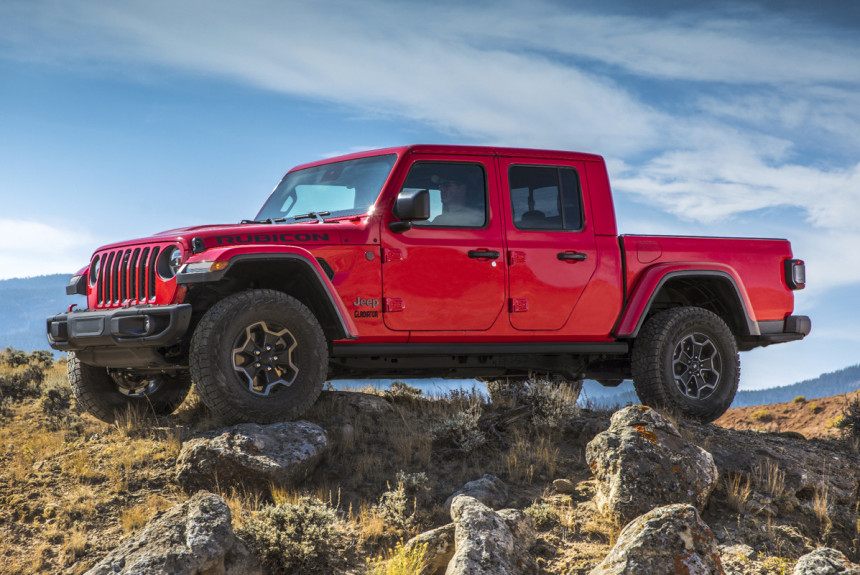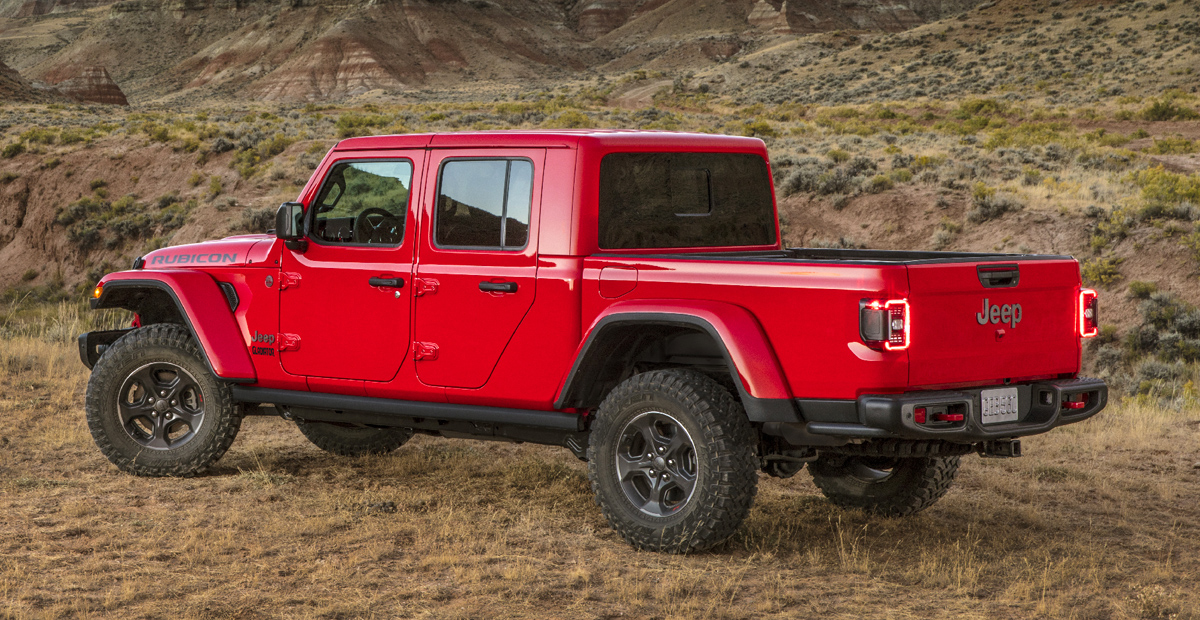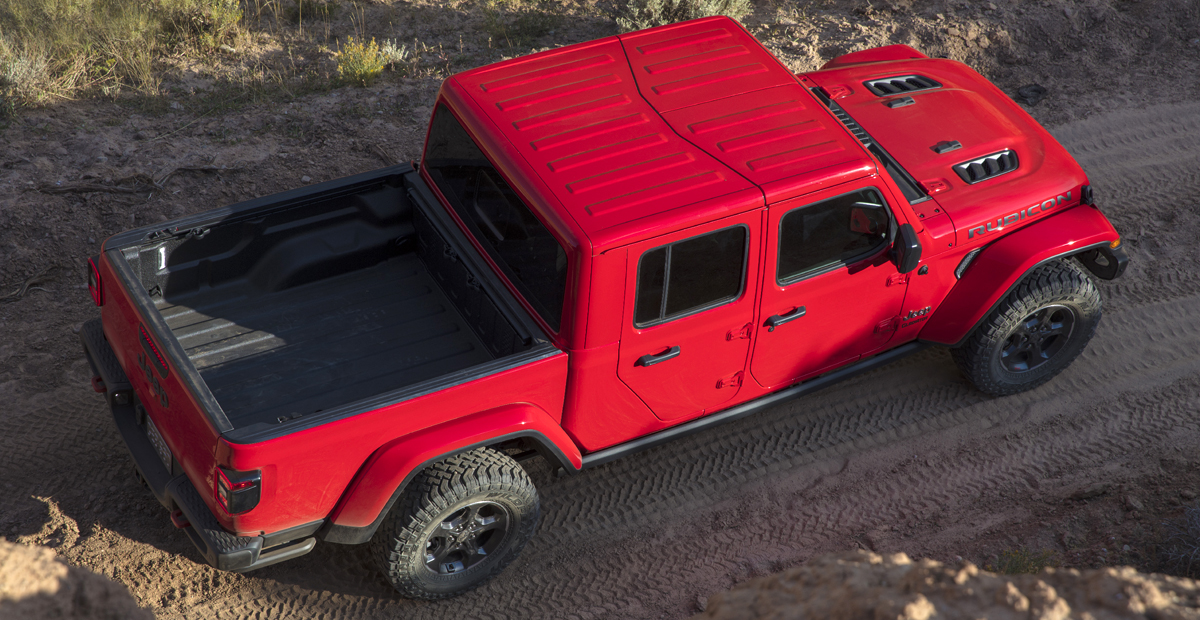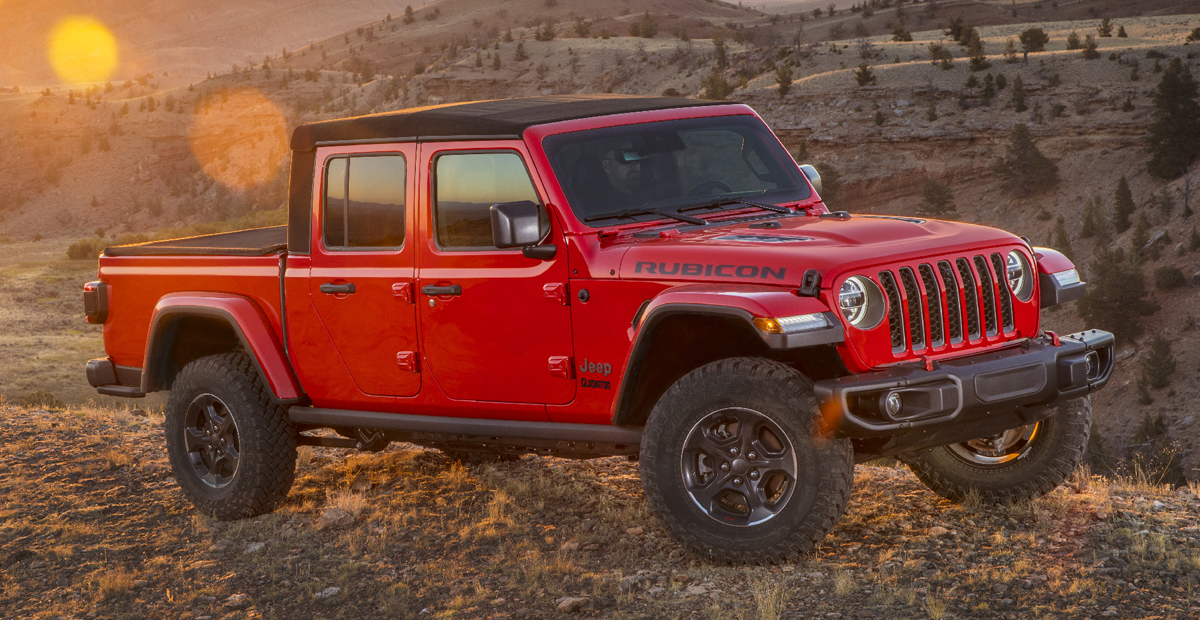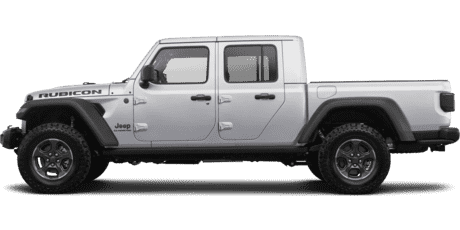- Новый Jeep Gladiator вернул марку в сегмент пикапов
- 2021 Jeep Gladiator
- Overview
- What’s New for 2021?
- Pricing and Which One to Buy
- Engine, Transmission, and Performance
- 2021 Jeep Gladiator Mojave Pros And Cons: The Different Jeep
- Focus on high-speed desert running sets this Jeep apart.
- Purposefully Built
- Still A Convertible
- Better Every Day Than A Rubicon
- Stuck With The Base V6
- Barely More Efficient Than A Raptor
- $65,000
- 2021 Jeep Gladiator EcoDiesel First Drive Review: Do The Twist
- Jeep’s novel pickup gets treated to a grunty diesel engine.
- Husky Hauler
- Clean Diesel, Dirty Fun
- Making Cents
Новый Jeep Gladiator вернул марку в сегмент пикапов
Пикапы были в модельном ряду марки Jeep с 1947 по 1992 год, но потом их убрали из-за внутренней конкуренции с грузовичками Dodge. Сейчас за этот сектор рынка в концерне FCA отвечает марка Ram, однако уже более десяти лет руководство Джипа вынашивало идею сделать стильный пикап для активного отдыха на базе Рэнглера. Наконец его время пришло: на автосалоне в Лос-Анджелесе дебютировал грузовичок под возрожденным именем Jeep Gladiator. И это первый в истории марки пикап с полноценной двухрядной кабиной.
Новый Gladiator не просто четырехдверный Wrangler с грузовой платформой вместо багажника. Колесная база растянута на 493 мм — до 3501 мм, а вкупе с увеличенным задним свесом общая длина рамы выросла на 787 мм. Грузовая платформа длиной 1,5 м сделана из стали, хотя откидной задний борт алюминиевый. Внутри отсека размещена 110-вольтовая розетка для устройств мощностью до 400 Вт.
Разумеется, Gladiator уступает Рэнглеру по геометрической проходимости, но и он обладает недюжинными способностями на бездорожье: клиренс достигает 282 мм, глубина преодолеваемого брода — 760 мм. Как и у Рэнглера, подвеска всех колес пружинная, грузоподъемность пикапа — 726 кг, а вдобавок он может тянуть прицеп массой до 3470 кг. Кстати, для лучшего охлаждения двигателя в тяжелых условиях у Гладиатора по сравнению с Рэнглером слегка увеличены фамильные прорези перед радиатором.
По части оснащения и опций пикап ни в чем не уступает донорскому вездеходу. Он точно так же может иметь как мягкий верх, так и съемные жесткие панели крыши (в этом случае сзади установлено стекло со сдвижной секцией). Все четыре двери можно снять в гараже, а лобовое стекло откинуть на капот. За откидной спинкой полноценного заднего сиденья оборудованы отсеки для аптечки и других мелких вещей.
Двухлитровый четырехцилиндровый турбомотор, который появился у Рэнглера нового поколения, Гладиатору не положен. Пикап выйдет на рынок с единственным атмосферником V6 3.6 (289 л.с.), который сочетается с шестиступенчатой «механикой» или восьмиступенчатым «автоматом». В 2020 году также появится версия с турбодизелем V6 3.0 (264 л.с.), которому положен только «автомат».
Нет в арсенале пикапа и самой простой трансмиссии Selec-Trac без демультипликатора. Стандартный вариант — Command-Trac с муфтой подключения переднего моста и понижайкой, а экстремальная модификация Jeep Gladiator Rubicon имеет трансмиссию Rock-Trac с еще более короткой понижающей передачей, блокировками дифференциалов и отключаемым передним стабилизатором.
Пикапы будут выпускать на заводе концерна FCA в Толидо, причем на той линии, которую до недавних пор занимал Wrangler прошлого поколения. Ведь новый Wrangler прописался на другой площадке, которая, впрочем, тоже находится в Толидо. Старт продаж на американском рынке намечен на второй квартал 2019 года.
Источник
2021 Jeep Gladiator
Review, Pricing, and Specs
Our car experts choose every product we feature. We may earn money from the links on this page.
- Highs Always off-road-ready, doorless and roofless configurability, can haul and tow more than a Wrangler.
- Lows Busy behavior on the highway, unimpressive fuel economy, not as nimble on the trails as a Wrangler.
- Verdict The Gladiator gives Jeep fans and off-roaders a more versatile tool that’s still really cool.
Overview
Jeep hasn’t offered a model with a cargo bed since the early ’90s, but the 2021 Gladiator finally gives the brand’s fans a cool and useful tool. The mid-size pickup truck is basically a more versatile version of the popular Jeep Wrangler, which earned it an Editors’ Choice award. It tows more (up to 7760 pounds versus 3500) than its SUV counterpart, and its longer wheelbase helps it ride better, too. Still, the truck requires regular steering inputs when cruising on the highway to keep it from straying, and it’s not as easy to maneuver on the trails as the smaller Wrangler. Along with a strong V-6 and a standard stick-shift transmission, the Gladiator offers a torquey diesel engine option with 442 lb-ft. While the 2021 Gladiator can get pricey in a hurry, its removable body panels and rugged persona make it one of the best pickups around.
What’s New for 2021?
Jeep hasn’t announced the full roster of changes to the 2021 Gladiator lineup, but it has confirmed what we’ve known for a while: the truck with a seven-slot grille will add a diesel engine option. The oil-burning 3.0-liter V-6 will develop 260 horsepower and a substantial 442 lb-ft of torque. Although we’re still waiting on pricing and EPA fuel-economy figures, we’re told the diesel will be offered on the Sport, Overland, and Rubicon models.
Pricing and Which One to Buy
We think the Sport S is the perfect canvas to create our ideal Gladiator. It comes standard with the 285-hp V-6 and a manual transmission. Ours would wear flashy Hydro Blue paint with the optional color-matched fenders. We’d also choose the all-terrain tires and anti-spin rear differential for improved traction when the blacktop ends, and we’d add the side steps to make getting in out and easier. We’d also select the three-piece hard top for its ability to quickly open up the roof. Inside, we’d add the headliner for better noise and temperature insulation and upgrade to the larger 8.4-inch touchscreen, because it adds navigation and is more sophisticated than the standard 5.0-inch unit. Our other preferred options include the Cargo Management pack (400-watt power inverter, an under-seat storage bin, and a bed-mounted 115-volt outlet) and the auxiliary switches and upgraded charging system for any lightbars or accessories that we’ll surely add for maximum Jeepness.
Engine, Transmission, and Performance
The Gladiator is powered by a 3.6-liter V-6 that produces 285 horsepower and 260 lb-ft of torque routed through a standard six-speed manual transmission or an optional eight-speed automatic. We tested an Overland model with the automatic, which needed 7.2 seconds to scoot to 60 mph. In other words, it’s slightly slower than most competitors. The Jeep adds a diesel 3.0-liter V-6, which develops 260 ponies and a mighty 442 lb-ft of twist. Compared with the regular Wrangler, the Gladiator has an extra 19.4 inches between the front and rear wheels. Jeep says this helps improve the pickup’s ride and handling. Now that we’ve driven several examples, we can confirm that it drives much like the Wrangler. The truck’s steering isn’t extremely precise and the ride can be busy on uneven surfaces. Still, these characteristics are part of the formula that make the Gladiator both a legitimate pickup truck and a trail-ready tool. Most enthusiasts care about the truck’s off-road equipment anyways, which includes everything from copious skid plates to rock-crawling axle ratios to the ability to ford up to 30 inches of water. Generous ground clearance and approach/departure angles further help the Gladiator conquer parts unknown.
Источник
2021 Jeep Gladiator Mojave Pros And Cons: The Different Jeep
Focus on high-speed desert running sets this Jeep apart.
Jeep is not a brand that typically steps out of its very particular box. It’s an SUV manufacturer that builds vehicles for slowly lumbering along a trail or up a rocky path. And while there are exceptions to every rule (hello Grand Cherokee Trackhawk!), its vehicles take the Trail Rated badges seriously.
That’s why the Jeep Gladiator Mojave is such a breath of fresh air. Rather than a vehicle designed solely for crawling up rocky outcroppings, it takes a page out of the Ram TRX’s book. This is a desert runner, a thing designed for dust, dunes, and high speeds. Unfortunately, it only has the hardware for the first two items, not the third. At the same time, the Gladiator Mojave suffers from some of the same ills as the Gladiator Rubicon. We like it a whole lot, but between purpose and price, it’s a little hard to understand the Mojave’s role.
save over $ 3,400 on average off MSRP* on a new Jeep Gladiator
Purposefully Built
With respect to Jeep’s popular Rubicon and Trailhawk trims, we’re all-in on the Mojave-specific details. From the orange accents, to the meaty 2.5-inch Fox shocks, to specific drivetrain changes designed specifically for the Mojave’s desert-running mission, this Gladiator feels like a long-overdue complement to Jeep’s off-road enthusiast lineup.
There are practical benefits to these changes, too. The Mojave-specific shocks and the Gladiator’s longer wheelbase made this inarguably the most stable member of the broader Wrangler family – on paved roads, we experienced little of the solid-axle wobble we’ve come to associate with Jeep’s most traditional vehicles. And faced with washboard dirt trails, the Gladiator Mojave proved plenty happy to bound over them at speed, its uprated shocks and 33-inch tires absorbing the worst of the abuse.
Still A Convertible
We’ll never get tired of yanking the roof and doors off a Jeep. Okay, that’s a lie, because the doors are heavy as hell and you’ll need two people to wrangle (pun intended) the available hardtop. The entire process is exhausting. But after a bit of work, there are few vehicles that can match the elemental driving experience of a roofless, doorless Jeep. The Gladiator Mojave doesn’t really add much to this formula, but hey, occasionally we need to remind brands that things are cool and they should keep doing them. Carry on, Jeep.
Better Every Day Than A Rubicon
This might be controversial, but the Gladiator was already our favorite member of the extended Wrangler family because of the way the longer wheelbase makes everyday life more tolerable. The Gladiator Mojave extends that lead, giving Jeep’s pickup truck all the attitude and style of a Rubicon without sacrificing much in the way of on-road livability.
The ride is more composed, and while it’s fair to argue that you’re giving up breakover angle and enlarging the Wrangler’s tight turning circle by moving to the Gladiator, we find those minor sacrifices unless you’re off-roading on a literal daily basis. If that’s the case, carry on with your Wrangler. But for those who only spend a few days a month in the dirt, the Gladiator and specifically the Gladiator Mojave is better balanced and more livable.
Are You Not Entertained?
Stuck With The Base V6
It’s a real shame Jeep sticks Mojave owners with the default 3.6-liter V6. It’s not that the Pentastar is bad – okay, it is old – but that the 3.0-liter diesel engine or the Wrangler’s mild-hybrid four-cylinder offer improved performance with other tangible benefits. Specifically, both the turbocharged 2.0-liter and the oil burner provide far more low-end torque, which the V6 is desperately short on.
Sure, ordering either of these engines means giving up the option of a six-speed manual transmission, but the eight-speed ZF automatic is good enough to make that an easy trade. The diesel is also quite a bit quieter than the Pentastar, which grows wheezy and unpleasant as the engine speed climbs.
And if we’re making wishes, the Gladiator Mojave’s purpose makes it seem like an obvious choice for a 392 variant. So yeah, Jeep, if you’re reading, let’s get on that.
Barely More Efficient Than A Raptor
The other reason we’d opt for a different engine comes down to fuel economy. With just 285 horsepower, 260 pound-feet of torque, and an EPA-estimated fuel economy rating of 17 miles per gallon city, 22 highway, and 19 combined, the Gladiator Mojave is down 165 horsepower and 250 pound-feet of torque on a Ford Raptor. And yet, the twin-turbocharged Ford F-150 Raptor nets 15 mpg city, 18 highway, and 16 combined. According to the EPA’s website, you’ll save $500 per year on fuel costs with the Gladiator, but we’d happily hand over all that extra coin for the added power and torque.
$65,000
You might be wondering why we brought up the Raptor. It’s because our Gladiator Mojave’s as-tested price matches the hi-po F-150’s starting price. Sure, the Jeep is substantially cheaper in its base form – $43,875 – but you’ll have to give up a whole lot of gear to maintain that price. You won’t get a hardtop, or an 8.4-inch touchscreen, the eight-speed automatic transmission, LED headlights, leather upholstery, a forward-facing camera, or any of the active safety gear.
The good news is that a stripped-out Gladiator Mojave will be mechanically identical (gearbox aside) to our $65,000 test truck. While we’d miss some of that equipment, nothing about this truck felt like it was carrying $21,000 worth of options.
Источник
2021 Jeep Gladiator EcoDiesel First Drive Review: Do The Twist
Jeep’s novel pickup gets treated to a grunty diesel engine.
The Jeep Gladiator is a unique proposition on the truck market, offering the personality of a Wrangler in a longer, more cargo- and towing-friendly form. Of course, that means it comes with all of the compromises of a Wrangler, including a rather soulless standard 3.6-liter V6. While the corporate Pentastar engine does well enough in cars and minivans, it’s not torquey enough for off-road truck duty. Enter the 2021 Jeep Gladiator EcoDiesel.
It’s not all that surprising to see Jeep offer the 3.0-liter EcoDiesel V6 on the Gladiator, given it arrived in the Wrangler Unlimited for the 2020 model year. Available on every trim level but the Mojave, the turbodiesel mill thoroughly transforms the Gladiator’s character, both on-road and off, by adding more torque over the standard Pentastar V6. Even though it technically loses some ponies, trust us, you won’t miss them.»
Husky Hauler
Adding 178 pound-feet can have that effect – the Gladiator EcoDiesel produces 442 stump-pulling units of twist, compared to just 260 for the Pentastar V6. Accompanying that torque is 260 horsepower, down 25 compared to the gasser.
In around-town driving, the Gladiator EcoDiesel has some unavoidable turbo lag, but off-the-line response is at least as good as the gas V6. And once that turbocharger kicks in, a smooth rush of torque – with a peak that lasts from 1,400 to 2,800 rpm – pushes the decidedly un-aerodynamic Gladiator through the breeze with authority. Passing and merging maneuvers that might require a flat foot in the Pentastar only need a big toe’s worth of pressure in the EcoDiesel, its eight-speed automatic gearbox doling out twist dutifully without requiring a screaming downshift.
The small-displacement diesel also produces only a little perceptible shake at idle, and the behavior smooths out completely once underway. What’s more, with the doors and roof panels installed, the oil-burning power plant under the hood makes its presence known with a mere whisper of diesel clatter, growing in volume (but not harshness) when the driver adds some throttle. Diesel owners appreciate some audible feedback that they’re driving something a bit different, so the noise is totally welcome in this application.
And surprisingly, the much heavier EcoDiesel improves the Gladiator’s on-road handling somewhat – equivalent models gain about 300 pounds in the switch from Pentastar to EcoDiesel. The engine’s extra weight calms down the vague, meandering front end, giving the driver more confidence on twisting roads and at speed.
The trailer weight rating tells a different story. In spite of its added grunt, the EcoDiesel’s maximum towing capacity is only 6,500 pounds, down from the 3.6-liter V6’s 7,650. The Gladiator Rubicon EcoDiesel, meanwhile, is only rated to tow 6,000 pounds, down from the gasser’s 7,000. Jeep admitted that the seven-slot grille couldn’t provide the airflow needed to keep the turbocharged diesel cool when lugging that much weight, and the Gladiator’s solid bumpers and short front overhang don’t leave enough space to mount an auxiliary engine cooler. Nevertheless, we suspect an EcoDiesel would still haul with more authority up to that max than a Pentastar.
Clean Diesel, Dirty Fun
To no one’s surprise, the Gladiator is a riot off-road. On the steep, narrow trail Jeep chose for our drive, an EcoDiesel-equipped Rubicon might as well have been a bighorn sheep for how adroitly it handled obstacles. As on gas-equipped Gladiators, the EcoDiesel Rubicon gets a two-speed transfer case with a shorter low range – 4.0:1 as opposed to 2.72:1 on the Sport and Overland. The diesel engine’s brawny twist and the transfer case’s aggressive torque multiplication allow the Gladiator to idle over large obstacles, even without throttle application. That kind of control in off-road situations is a wonderful thing.
Helping in the truck’s rugged mission are the Rubicon’s standard selectable front and rear lockers. The locked differentials provide plenty of traction, ensuring power gets to the ground even when one wheel is in the air. Preventing that phenomenon is the work of the electronic-disconnecting front sway bar. With the sway bar disengaged, axle articulation is incredible, helping keep both front wheels on the ground even when traversing a large ditch diagonally or driving through rutted terrain.
Although our time off-road was short, it was enough to prove that the presence of the hulking EcoDiesel’s V6 torque would only improve the Gladiator’s off-road aspirations.
Making Cents
The EcoDiesel demands $4,000 over an equivalent, automatic-equipped Pentastar Gladiator, and since the EcoDiesel isn’t available with a manual transmission, it costs $6,000 over the base powertrain. That brings the Gladiator Sport EcoDiesel’s base price up to $39,545 plus $1,495 for destination, while the Rubicon starts at $49,875. At the top of the range is the luxurious Gladiator High Altitude, demanding $55,500 for the EcoDiesel variant plus destination and options.
Improved fuel economy helps blunt that cost – the EPA rates the Gladiator EcoDiesel at 22 miles per gallon city, 28 highway, and 24 combined, while the Gladiator Rubicon achieves 21 city, 27 highway, and 24 combined. That’s up from an auto-equipped Pentastar’s 17, 22, and 19 mpg.
Источник
